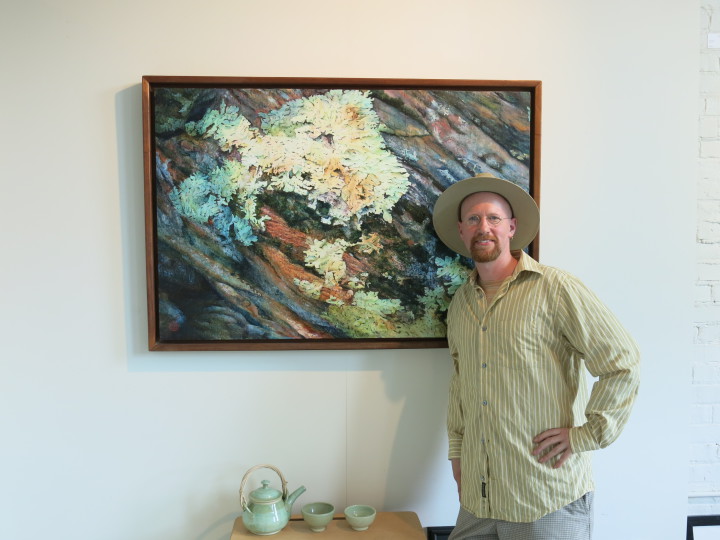On October 1, 2005, tropical storm Stan made landfall on the Yucatan Peninsula, in Southeastern Mexico. Once the storm entered the Bay of Campeche it gained momentum and was reclassified a hurricane.
At the time of the storm, artist Mark Harmon (who now lives in Asheville) was camping on the beach in Tulum. Six weeks ealier, the German-born painter had arrived to the area by way of Madison, Wis. His plan was to stay in Mexico for two years. A small backpack filled with watercolor supplies was all he carried with him.
“It’s a beautiful Mayan ruin,” Harmon says, recalling Tulum from inside his whiteSPACE studio (on the second floor of the Wedge building in the River Arts District). “You’ve got the stone structure and the ocean smashing up against the rocks and the spray coming in your face.” It was the sort of beauty that inspired early watercolor works that Harmon sold to tourist in Tulum.
On the night of the storm, however, the beauty was submerged beneath the knee-deep water that filled Harmon’s tent. The rising sea levels didn’t cause panic, though; instead Harmon went for a swim. “You were already as wet as you were going to be,” he says.
By morning, Harmon learned more than 200 people across Central America were killed in the storm. The news shook him. “I thought of myself as the adventuring painter on the beach, you know, but I could have just been some dead guy.”
That possibility led Harmon to seek higher grounds. He made his way to San Cristobal. “It’s the most indigenous Mayan region in Mexico,” he says. “Something like 40 percent of the population are native Mayan speakers. So imagine this sunburned red-bearded guy showing up with nothing more than an easel and his paints.”

But San Cristobal — a sister city to Asheville — embraced the sunburned artist, and the sunburned artist found inspiration in San Cristobal. What Harmon planned as a two-year stint, turned into a nine-year stay. The area’s history and architecture fascinated him, manifesting itself in much of his work.
A few of Harmon’s watercolor adobes can be found in his whiteSPACE studio. “San Cristobal was founded in 1535 and there was still structures around from that time,” he says. “The texture and the sort of beautiful visual language that time, weather, wind [and] sunshine had worked on these structures is the same that I find exciting in the Appalachian Mountains.”
Harmon and his wife, Geny Hernandez, arrived to Asheville in April of 2013. Part of the appeal stemmed from a brief three-day hike Harmon took on the Appalachian Trail, 10 years earlier. Asheville also reminded Harmon of his childhood in Heidelberg. “It’s very much like the landscape there,” he says. “It’s mountainous; there’s a river running through it. No matter where you are, you always see mountains. I feel the same way here in Asheville. And oddly enough [San Cristobal] was the same kind of story. It was a mountain valley. You’d look around and there were always peaks.”
Since relocating, Harmon’s focus has shifted from architecture to lichen, a composite organism that emanates from algae living among filaments of a fungus in a symbiotic relationship. They come in a variety of colors and are found locally on trees and rocks. Harmon admires the composite organism’s ability to survive extreme weather, be it heat, cold or drought. “They’re tough as nails,” he says, tapping his knuckles against one of his paintings.
Harmon’s physicality with his work compliments the subject, but also plays into his greater concern of time. The painter prefers panel to canvas and builds the constructs himself. He uses a modified 13th-century approach that he learned while studying in Slovakia. He makes his own pigments, paints and gesso. The wood panels are covered in linen. The cloth, explains Harmon, rides out the wood’s expansion. Rabbit skin glue and a calcium carbonate linseed oil gesso are then applied as a coat. “These are built for the centuries,” he says, tapping his work again.
Harmon, whose father earned a PhD in art history, grew up visiting old European churches and museums. The early exposure continues to influence the way he views his own art. “I like history and I like the trace of history,” he says. “I might not be the most important painter now, but if [my paintings] are still around in 1,000 years, someone’s going to care. You dig these up and people are going to want to know what they’re about. And that’s a puzzle I’d like to set up for them.”
Mark Harmon’s work can be found at the Asheville Gallery of Art, Riverview Station and whiteSPACE. For more on the artist, visit www.MarkHarmon.org




Thomas, thank you for the great article about my dear husband Mark Harmon. Muchas gracias!
De nada. It was a pleasure hearing the stories he shared.